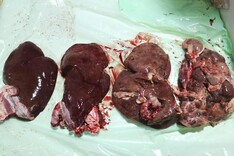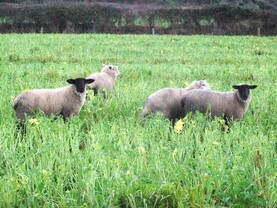Recent wet weather has led to housing for many suckler farms throughout the country.
An exceptionally wet and mild autumn not only led to good growth rates early on in October, but also led to ideal conditions for parasitic life to reproduce.
While the dry summer and early autumn led to low levels of fluke and worms present on pasture, their ability to multiply given the right conditions can not be underestimated.
Sampling and diagnosing
There is currently no known resistance to flukicides, but routine dosing should not be completed where there are no clinical signs or presence of fluke eggs in a faecal sample.
A fresh, pooled (from several animals) sample should be taken and presented to your vet or to a lab as soon as possible.
Results received should dictate dosing protocol, although farmers should also use their own initiative and watch for clinical signs of liver fluke.
Clinical signs are less pronounced in cattle than in sheep. However, the presence of liver fluke can present issues such as reduced liveweight gain and FCE (feed conversion efficiency) and reduced fertility in autumn-calving cows.
While bottle jaw is more common in sheep flocks, it can present itself in cattle and is similar to timber tongue, with a swelling of fluid beneath the jaw, although the tongue will remain unswollen if it is a fluke problem.
Dosing protocol
If a fluke drench is required, the efficacy of the product against different life cycles of fluke needs to be considered before drawing up a drenching programme.
Certain products are only effective against the adult stage of liver fluke. Where a drench like this is used at housing, farmers should follow up 10 weeks later with a second drench.
All early immature and immature fluke that were not killed at the first drenching will now have become adults, with a second drench required to kill these.
Alternatively, farmers can use a drench that will cover all three stages that will not require a follow-up drench.
Rumen fluke
Traditionally, the rumen fluke was not considered to be a significant parasite among Irish cattle, mainly because it was only seen in very low numbers, and was not associated with clinical disease.
In recent years, however, a number of very severe outbreaks with multiple fatalities have focused attention on the rumen fluke.
It is important to remember that the detection of rumen fluke eggs in faecal samples, or the detection of the adults in small numbers in the rumen, is not in itself a reason to institute specific control measures, as light infections appear to have no effect on animal health or productivity.
The routine implementation of a preventive dosing regime for rumen fluke is rarely justified, except on farms where severe disease and losses have been confirmed in the past.
Due to the rarity of severe outbreaks, such a control programme would be best designed and tailored for the specific farm in question, following consultation with your own veterinary practitioner.
Such a programme would aim to use treatment in a strategic manner to reduce the pasture contamination, in association with other measures mentioned previously. As with all fluke treatments, a tailored approach should be carried out as opposed to a blanket treatment to reduce the likelihood of resistant strains.






 This is a subscriber-only article
This is a subscriber-only article










SHARING OPTIONS: